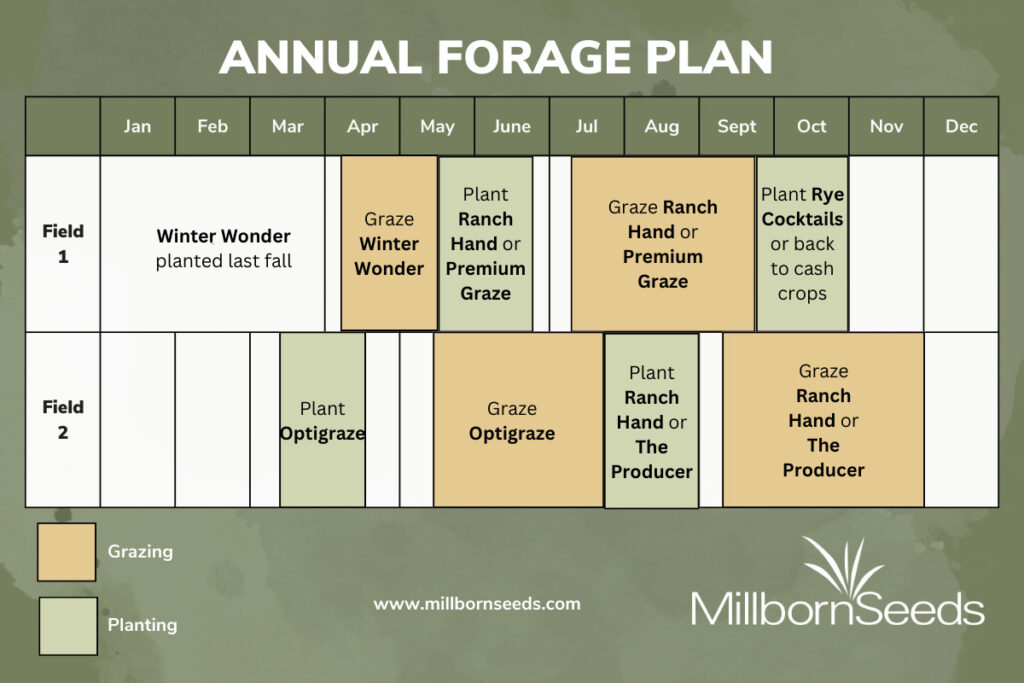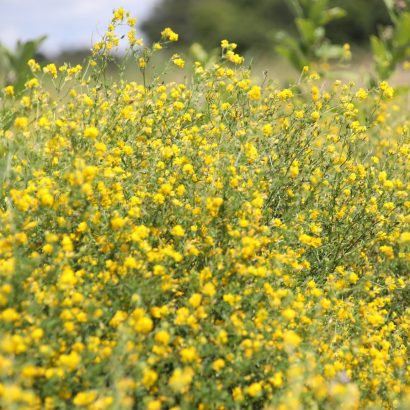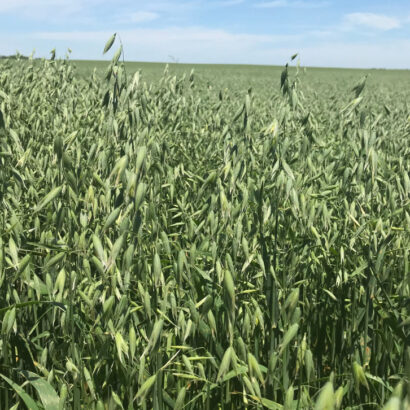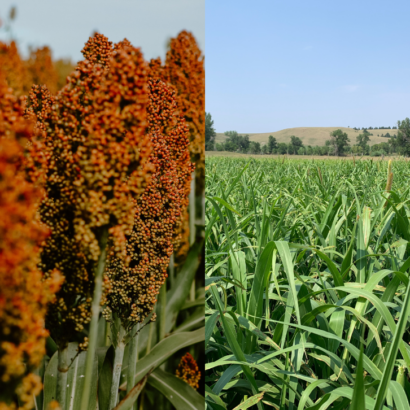The winter season is a great time to make a plan for your annual forage systems next year. We mapped out an example of what this could look like on two different fields, so you always have grazing area available for livestock.

Field 1
First up, we recommend starting earlier than you may think. Dormant seeding a winter annual in the fall is a great way to get ahead of your spring forage plan. When choosing what to plant, you’ll want to choose a mix of species that will over-winter well, and has a variety of plant types to ensure a productive stand in the spring. Millborn’s Winter Wonder is a mix of winter annuals that is known for greening up well in the spring – and it has a nice variety of a grass, a legume, and a brassica included in the mix. The trio of rye, winter camelina and hairy vetch provide a lush forage option when it breaks dormancy in the spring. If you do choose to use Winter Wonder, we recommend grazing cattle on this mix when the rye is about five to eight inches tall – this will help you utilize the forage for the longest possible duration.
Continuing in the first field, after you’ve grazed your dormant seeded mix (usually about mid-May at this time), you’ll want to plant an option that will be ready for grazing in late summer (July – September). For this time of year, you’ll want a product that can withstand the heat of summer and is a match for the rainfall you get in your area. Be sure to also look for a product that can be grazed, or cut and stored for winter to add flexibility to your feeding plans.
If your area tends to get adequate rainfall in the summer, a product like Premium Graze would be a good fit for mid-May planting and July – September grazing. The sorghum sudangrass and millet in the mix provide high levels of dry matter production, while the forage brassicas in the blend increase the overall protein and digestibility of the product.
Even if your area isn’t as fortunate in the rainfall department, that doesn’t change your need for quality feed options. We recommend looking for a mix with a wide variety of crop types to ensure success, even in tough conditions. The higher the diversity of the mix, the more likely you are to have an established stand. A product like Ranch Hand combines 10 different seeds to ensure that it will establish a stand and provide grazing options – even in tough conditions.
After you’ve grazed your warm season mix, you have the option of dormant seeding a rye cocktail for a cover crop, or transitioning back to cash crops in the spring.
Field 2
For the second field, let’s assume a spring planting date, rather than fall, to give your operation more flexibility. It’s best to plant this as early as possible in the spring, so you have some early grazing options available. Because you’ll be planting early, you’ll want to look for cool-season crops that can provide cover and grazing throughout the summer and into fall. Look for something with oats to come up quickly, and then some brassicas or rye for season-long growth and grazing. Optigraze is a nice option for a cover crop mix that meets all these needs – the combination of oats, ryegrass and two different types of brassicas will stay lush and keep growing until temperatures get too cold in the fall.
Once you’ve finished grazing your cool season mix (usually about mid-July), you’ll want to plant another mix for grazing and cover. This time you’ll likely be planting the mix in mid-July, so the factors to consider are slightly different than when you were choosing your mix for Field 1.
Ultimately, selecting your mix will come down to evaluating the forecasted weather for the month of August and the remainder of the fall season. If the fall is expected to be cooler than normal, we recommend going with a cool season mix that will not only provide grazing options, but also scavenge nutrients and build organic matter in the soil. If the weather is expected to stay warm into the fall, you may be able to plant another warm season mix, but make sure it has some cool season crops in it to hedge your bet against the weather. The Producer is a well-balanced cool season mix of turnip, vetch, radish, flax and oats – all crops that will handle a cool fall well and continue to provide you grazing options while improving soil health. Ranch Hand will work well if you’re expecting a warm fall, because it has a wide variety of crops in it, meaning even if temperatures turn cool it can still maintain a stand throughout the fall.
Keep in mind that you’ll need to be on the lookout for freezing temperatures in the fall. Some crops, like the sorghum sudangrass in Ranch Hand, carry the risk of prussic acid poisoning after a frost. Keep your livestock off the mix for seven to ten days following a frost to ensure there’s no risk of injury to the herd. If you’re unsure if your mix can be grazed after a frost, reach out to your Millborn Seeds expert – they’ll be able to tell you everything you need to know about your specialty seed.
Make A Custom Plan
Our experts at Millborn enjoy putting together sample plans like this, but if you want to talk through the nitty gritty details of your farm, get in touch with one of our Forage + Cover Crop Specialists to create a custom plan that fits your specific forage and livestock needs.




Discussion
0 Comments